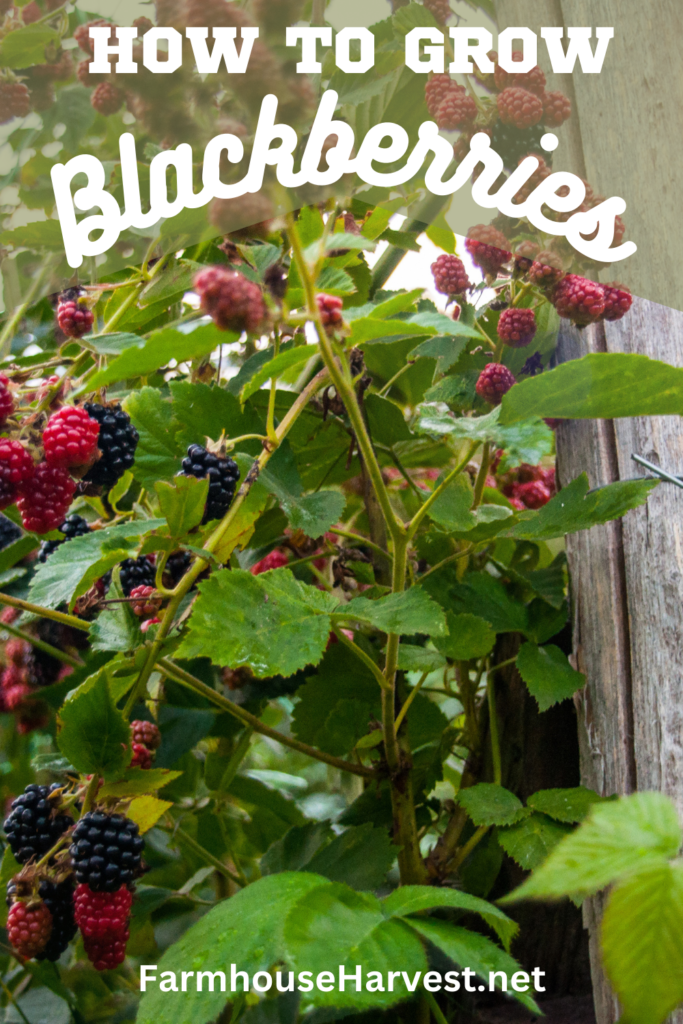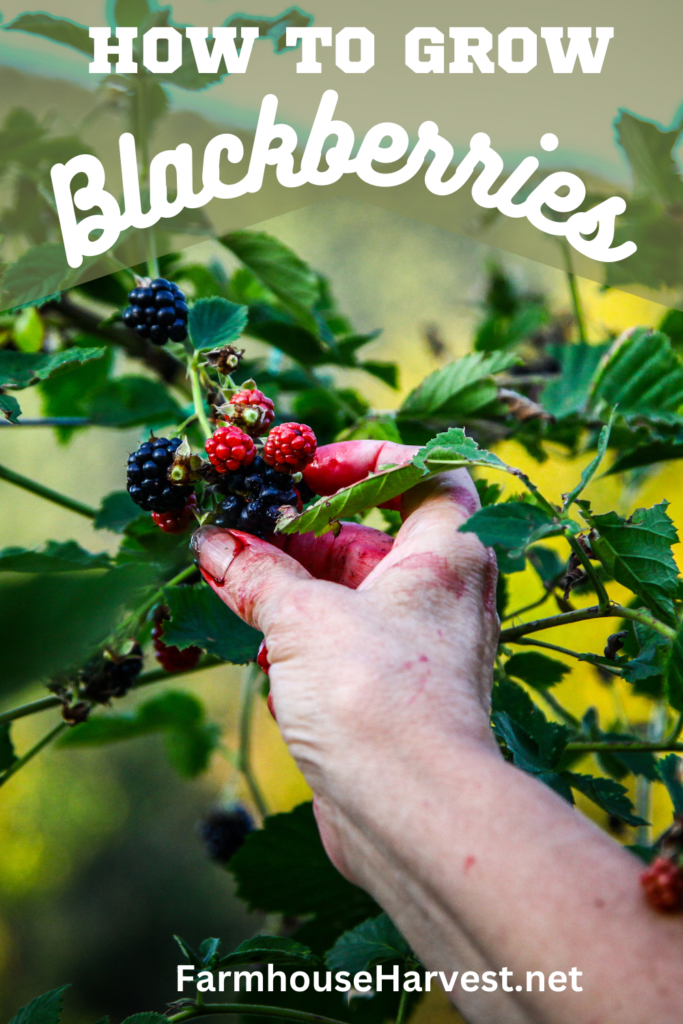We’ve been harvesting gallons of blackberries… And I’d love to teach you How to grow blackberries for in your backyard garden too. Whether you’re an experienced gardener or a beginner, growing blackberries is rewarding and can yield a huge harvest of sweet, juicy berries year after year!

Every year we grow gallons and gallons of delicious blackberries. I love to make smoothies, low sugar blackberry freezer jam, a simple blackberry crisp, and the best blackberry cobbler you’ve ever had with them! They freeze like a dream in gallon sized freezer bags, and last for a year in the deep freeze!
Choosing the Best Blackberry Plants for Your Garden
Blackberries are delicious fruits that are easy to grow throughout the United States. But before you start growing blackberries, you need to choose the right variety for your area hand hardiness zone.
Blackberries are perennial plants with a perennial root system, and different varieties have different hardiness levels. So choose choose blackberry plants that are suited to your climate and hardiness zone so they can thrive in your garden!
There are three primary types of blackberries: thorny varieties, erect varieties, and thornless varieties.
Thorny varieties are the wild cousins of cultivated blackberries and have long, spiky thorns.
Erect varieties have stiff canes that grow straight up and require a support system to prevent them from toppling over. Thornless varieties are the most popular type of blackberry and are easy to grow in a home garden. They come in both trailing and erect varieties, and they’re more tolerant of cold temperatures and insect pests than other types.
Thornless blackberries are easier to pick, but some gardeners prefer thorny varieties for their better taste. Some popular blackberry varieties to consider include “Loch Ness,” “Chester,” and “Triple Crown.”
Most Flavorful Blackberry Varieties
- Navaho as the best-tasting new blackberry.
- Arapaho is second.
- Kiowa is a thorny upright blackberry that could be the biggest blackberry in the whole world. I have a few of these and they’re not just big… They’re delicious!
How to Grow Blackberries – Step 1- Soil Prep
Blackberries require full sun to grow and produce fruit, so it’s essential to choose a spot in your garden that gets at least six hours of direct sunlight per day.
They also prefer well-drained soil that’s rich in organic matter and has a pH between 5.5 to 6.5. If your soil is heavy clay, you can amend it with garden compost or other organic matter to improve drainage and fertility. So don’t just put your blackberry starts in the ground… Before planting, amend your soil with compost, well-rotted manure, pine bark fines, or peat moss to improve drainage and fertility.

The Best Time To Plant Blackberries
Once you’ve chosen the right blackberry plants for your garden, it’s time to start planting…. The best time to plant new plants is in the early spring, just after the last frost. But, planting in the fall is also an option in warmer climates. Just avoid planting in the middle of summer when the temperatures are hot, so they don’t die!
Blackberry plants are usually planted in early spring, after the threat of frost has passed. They can be planted in the ground or in large containers filled with well-drained soil. When planting blackberry plants in the ground, make sure to dig a hole deep enough so that the base of the plant is at ground level.
If you’re planting bare-root plants, make sure to soak the roots in water for a couple of hours before planting. Once planted, make sure to water the plants thoroughly and apply a layer of mulch around the base of the plant to help retain moisture and suppress weeds.
Spacing Plants
When planting blackberry plants, make sure to plant them at the same depth they were growing in their nursery containers. Plant the blackberries 3 to 4 feet apart in rows that are 6 to 8 feet apart. After filling dirt in around the roots, gently firm the soil around the plants and water them thoroughly to help settle the soil.

Building Support for Blackberry Plants
Blackberry bushes can grow quite tall and need support to prevent them from toppling over. You can use a trellis, fence, or support wire to keep the canes upright. For trailing varieties, install a support wire 3 to 4 feet above the ground and train the canes to grow along the wire.
For erect varieties, install two support wires, one 3 feet above the ground and one. We use a wood cross post with wires on both sides of the cross to hold vines in and up.
We have to crosses on the posts, one up high and one about 2 feet off the ground. You will need to regularly go through your blackberry rows and train the canes to stay in the wires. Learn more about training your blackberry plants from the USDA!

Watering Blackberry Plants
Proper watering is essential for blackberry plants, particularly during the first growing season. During this time, the plant’s roots are still establishing themselves, and they require plenty of moisture.
We run a drip line under our blackberry canes. This waters for 1 hour each day during the hot months, and then we turn it down to water 1 hour every two days till September when we turn the water off for cold months. This avoids getting water on the leaves or fruit, as this can encourage fungal diseases. And, it provides the plants with a slow and steady supply of water… Sporadic watering can cause the soil to become waterlogged.
Make sure to water the plants deeply and regularly, so the soil is moist but not waterlogged.
Watering in the early morning or late afternoon is ideal, as it gives the leaves enough time to dry before the sun sets.

Mulching Blackberry Plants
Mulching is the best way to help blackberry plants retain moisture and control weed growth! Place a 2 – 3 inch layer of organic compost, mulch straw or wood chips, around the base of each blackberry plant. Make sure it doesn’t touch the base of the plant, just cover the dirt around it. Much too close to the blackberry vines can cause rot, and decay. 😉
The best way to mulch blackberries is to create a “donut” shape around the plant.
- Start a few inches away from the base of the canes.
- Spread your mulch outwards in a circle around the plant, making a donut shape..
- make sure to keep a gap of 2-3 inches between the mulch and the stems
Mulching also provides a barrier against pests and diseases in the soil. Plus, as the mulch breaks down, it adds nutrients to the soil and improves its texture!

Pruning Blackberry Plants
Just like raspberry plants, regular pruning is important to keep blackberry plants healthy and encourage new growth!
Prune out dead or damaged canes in winter, or early spring before new growth starts. This promotes new cane grow from the base of the plant. Then, remove the old fruiting canes… They can harbor pests and diseases.
It’s a two-step process with their canes, which are like their branches.
- Year 1: Primocanes – The Youngsters: When a new cane pops up from the ground in the first year, we call it a primocane. These young fellas are all about growing big and strong, getting their leaves and stems going. They’re not ready to party with flowers or fruit just yet! So, you won’t see any berries on these first-year canes.
- Year 2: Floricanes – The Fruit Producers: Now, those primocanes that grew in the first year? They become floricanes in their second year. This is when the magic happens! These second-year canes are the ones that will produce all those lovely blackberry flowers, which then turn into the juicy fruit we love.
You need to have canes from last year (was primocanes now floricanes) to get your harvest this year. Once a floricane has given you its berries, its job is pretty much done, and you’ll usually want to prune it out to make room for the new primocanes that will give you fruit next year.
If you keep your blackberry plants happy and healthy with good care and smart pruning, they can keep this cycle going for many, many years, giving you an abundant harvest year after year!

How to Harvest Your Blackberries
You’ve worked hard to learn how to grow blackberries… Now it’s time for your reward! Harvest!
Blackberries are typically ripe and ready to harvest in late spring or early summer, depending on the variety and time of year. Ripe fruit should be dark and shiny, with a juicy texture and sweet flavor. It’s best to pick ripe fruit every couple of days to avoid over-ripening and rotting.
We like to pick ripe blackberries every couple of days to avoid over-ripening fruit and rotting… Plus they’re so delicious, we just enjoy eating them!
To harvest blackberries, gently pick the fruit from the plant, being careful not to damage the new primocanes or new shoots. Harvested blackberries can be stored in the refrigerator for a couple of days, washed and frozen for later use, made into blackberry cobbler, low sugar freezer jam or blackberry crisp!

Blackberry Pests & Diseases
Blackberry plants can become infested with pests and fungal diseases, like Japanese beetles and purple blotch.
Keeping an eye on your plants for any signs of damage or disease is important…. You need to remove any infected or dead plants to prevent the spread of disease!
If you notice any issues, use balanced fertilizer to keep the plants healthy. It’s also important to keep the area around the blackberry plants clean and free of weeds and debris, which can attract pests and disease… Regular pruning can also helps keep blackberry plants healthy and reduces the chance of fungal problems.

Blackberry Recipes
There’s nothing better than a hot blackberry pie with ice cream… But there are so many ways to use homegrown blackberries including:
If you use this info to grow blackberries and love it, Tag me on Instagram @farmhouse_harvest with your crop!







3 comments
Penny
Blackberries are on our list to add to our garden this year! Thanks for the great guide!
Kara
Great post! I just finished pruning our 2-3 yo blackberry canes, and can’t wait to see what this year’s growth will be like.
Kayly
Such great information! Blackberries grow wild here in Arkansas, but I would definitely love to have some in my back yard. Will definitely be trying these tips 🙂